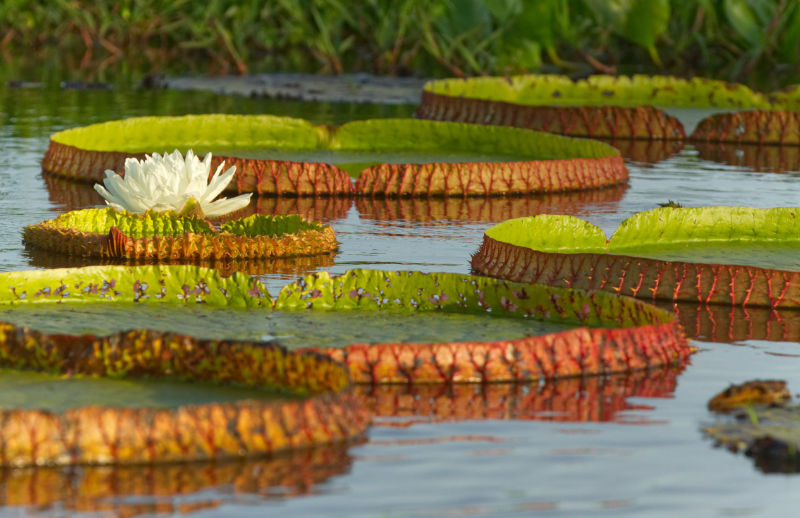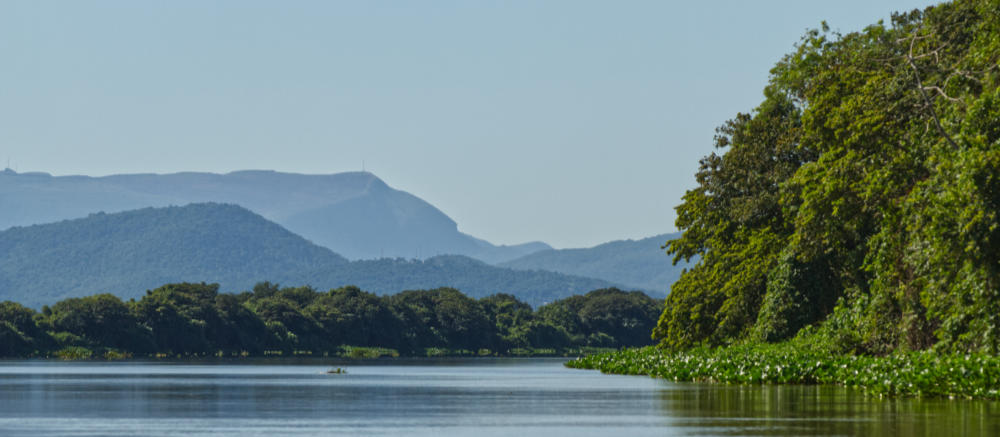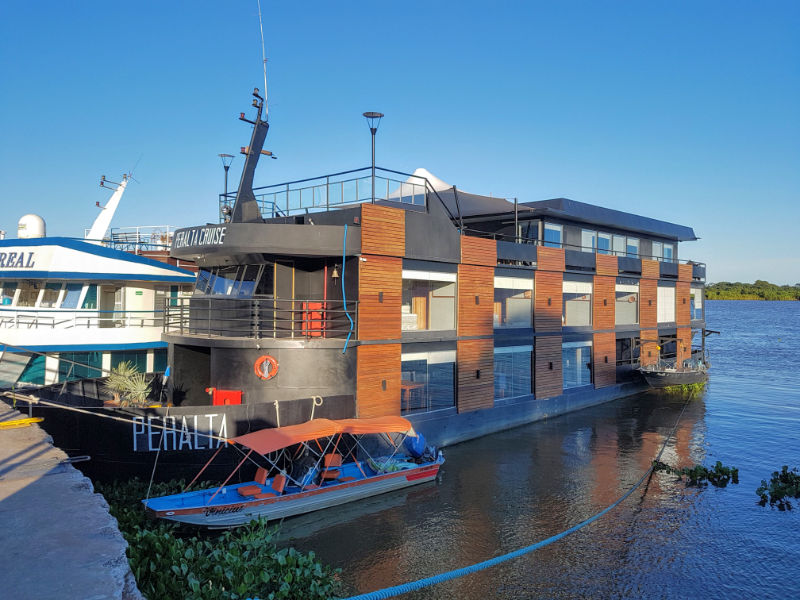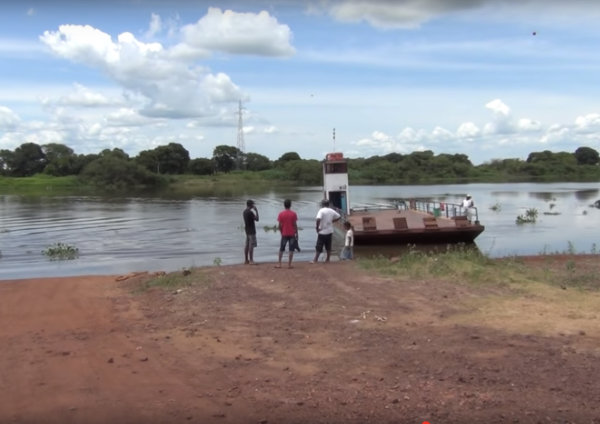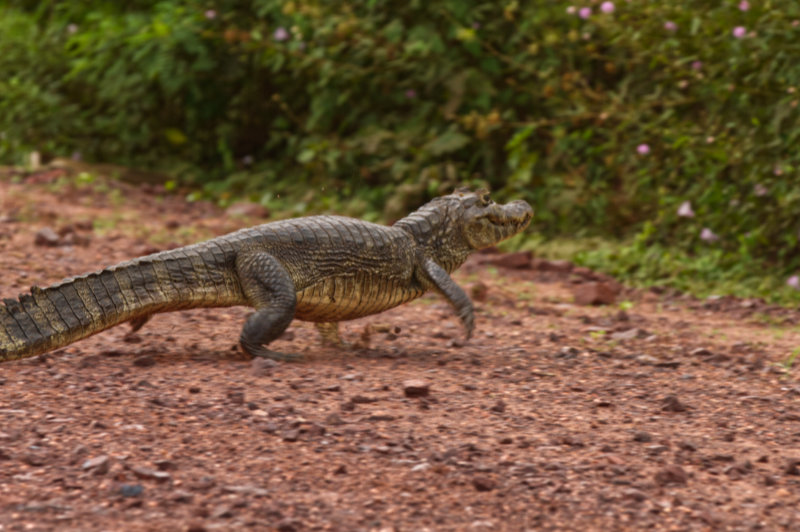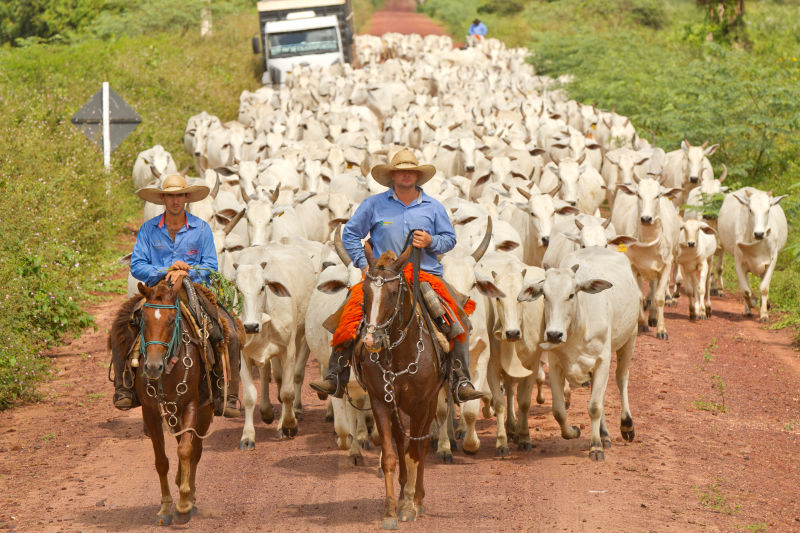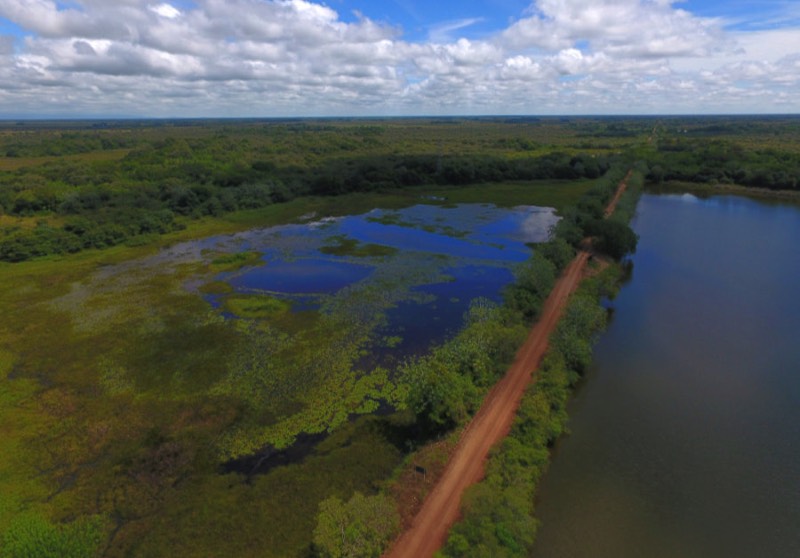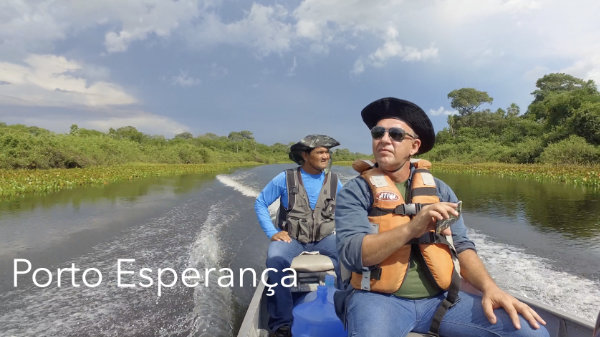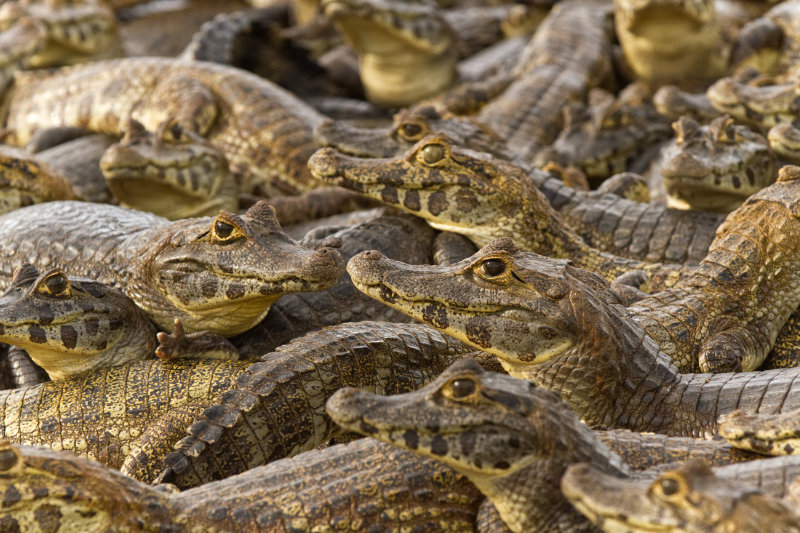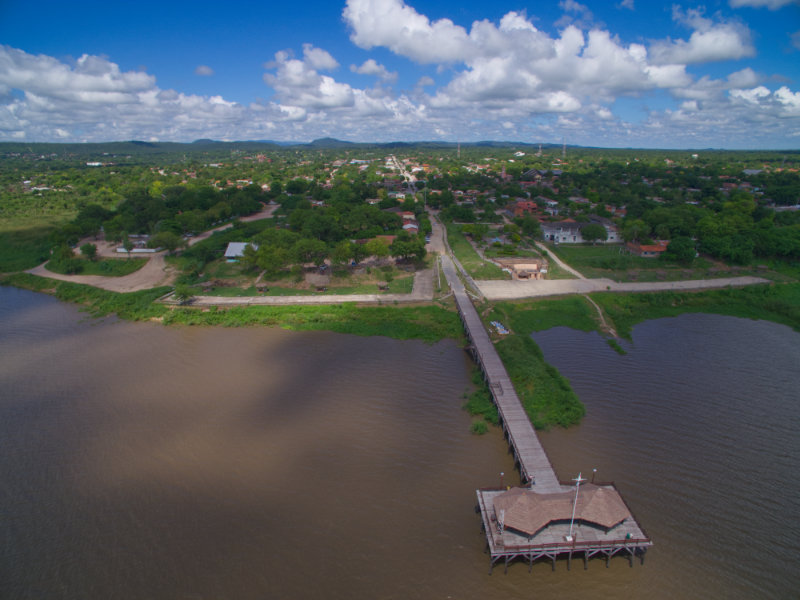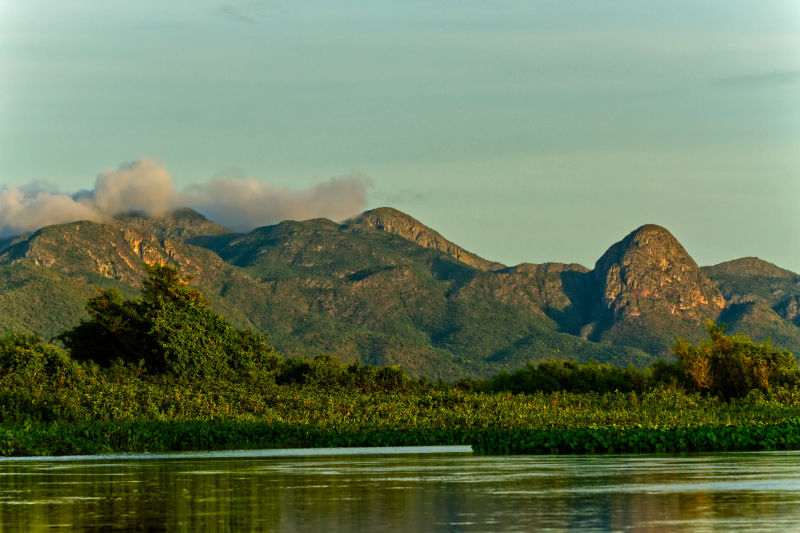Corumbá
Activities and Tours
Organised tourism activities within Corumbá are oriented towards Brazil's own internal tourism market - with a heavy emphasis on sports fishing. There are very few reliable English-speaking tour operators in town catering to international visitors - but there are options if you plan ahead.
River Cruises
A river cruise is one of the best options for introducing you to the Pantanal environment. We recommend taking a smaller boat headed northwards (past the aqueduct which arches over the river) towards the Serra do Amolar region. Even for short trips this can be a great opportunity to see bird life such as Cocoi Herons and Anhinga - albeit still from a distance. There's a good chance of seeing jacaré alligators and capybara along the riverbanks … and (if you're especially lucky) even a jaguar although this is a rarity. There are also nearby locations with giant Vitória Régia lily pads.
Zé Leôncio Viagens & Turismo (named after a famous soap opera character) will let you hire a small boat and driver, or travel as part of a group. Guides might only speak Portuguese but will do their best to assist. Perola do Pantanal offer larger tours on bigger vessels but these are oriented towards local Brazilian tourists - meaning less sightseeing, but more beer and very loud music.
Perola do Pantanal
Office in the Porto Geral: Rua Manoel Cavassa, 255
www.peroladopantanal.com.br
Barco Hotels and Fishing Lodges
If your enjoyment of the outdoors is enhanced by holding a fishing rod then the Pantanal is the perfect place for you. Most Brazilians visiting the region do so for fishing - and catering for these tourists is big business. There are many small riverside lodges situated in and around Corumbá and elsewhere in the region. These are set up with small boats, refrigerators and cooking facilities to suit private fishermen and groups.
Barco-Hotels (boat-hotels) are large motor launches with comfortable accommodations, food, drink and entertainment - fully crewed and promising to take you into the best fishing areas. Most vessels travel with a large number of dinghies in tow so their clientele can explore smaller channels where the larger vessel can't travel. Since most of the clientele is Brazilian there's very limited support for non-Portuguese speaking visitors. However, this is beginning to change with the some vessels now focusing on eco-tours passing through the Serra do Amolar region to the north of Corumbá and/or travelling further up into neighbouring Mato Grosso along the Cuiabá river. Both locations are offer good opportunities to experience the remote Pantanal and potentially see jaguars along the river banks.
Having lots of geared-up fishermen can be detrimental to the environment - but "catch and release" fishing is strongly encouraged. Target species are Dorado, Pintado, and Pacu. Even the humble and plentiful piranha are worth catching if you want to try the locally famous Caldo de Piranha spicy fish soup.
Nov-Feb: Piracema (spawning season)
Fishing is forbidden in the spawning season from November
through February. This is known locally as piracema -
an indigenous term (pira = fish, cema = jump).
Fishing lodges are often closed during these months.
Fishing licenses and rules
You'll need a state-issued fishing license.
Although there's also a federally-issued national license
its usability is limited within Mato Grosso do Sul state.
Unlike the federal version (which is issued for a year), the
state version can be purchased for just the month of your
stay and is cheaper. It can be completed online but with
payment being made at an agency of Banco do Brasil.
www.imasul.ms.gov.br
Joice Tur
Office in the Porto Geral: Rua Manoel Cavassa, 331
www.joicetur.com.br
Peralta Cruise
peraltacruise.com
Navio Kalypso
www.naviokalypso.com.br
Estrada Parque
This is the southern Pantanal version of the transpantaneira. It's an unpaved road servicing remote Pantanal communities and cattle ranches in the area between Corumbá and small town of Buraco das Piranhas.
- It covers 120km, including 87 wooden bridges,and several wooden observation towers. Wildlife is most concentrated in the low-lying area between Buraco das Piranhas and ferry crossing at Porto da Manga.
- The section between Porto da Manga and Corumbá passes over the Morraria do Urucum (Urucum hills). With the exception of birds, there's less visible wildlife. But, its cooler and there are no mosquitos.
- The cost of the ferry crossing at Porto da Manga is R$45 for cars, or R$20 for motorcycles.
- Fill up your car before you go as there are no petrol stations.
- There are small general stores at Porto da Manga and Curva do Leque selling cold drinks and snacks. Curva do Leque also has the Esquinão restaurant which offers simple but freshly prepared meals.
This is a great way to see wildlife, although the frequency of animals encountered will depend on the season, luck, and the skill/eyesight of your travelling companions. Typically, you'll see jacaré alligators, occasional capybara, and wide range of local birdlife. Lucky travellers may encounter anacondas, marsh deer, peccaries, and (on rare occasions) giant anteaters or even a jaguar.
Importantly, the Estrada Parque also provides road access to several local fazendas and tourist lodges. It's best to check the condition of the road with locals before travelling since it can turn into thick boggy mud during the wet season (Nov-Apr). A small fee is charged to vehicles carrying tourists by the Environmental Police (and administered by SEMATUR, the municipal tourism board) to help pay for the upkeep.
Travel is recommended only during the day, as crossing the bridges at night can be treacherous.
Farm Stays and Fazendas
If you're travelling out to the Estrada Parque to see wildlife, staying there longer at a Fazenda Hotel (farm stay) will maximise your chances. There are several good options to choose from - most of which provide guides and tours in addition to being functional cattle ranches.
- Typical packages offered are for three days and two nights, although you can arrange longer or shorter stays as you wish.
- These packages generally include horse riding, piranha fishing, guides treks and sometimes a boat trip and fishing depending on the location and season.
Below are the main fazendas offering stays along the Estrada Parque, although a fuller list can be found under our Accommodation heading. These fazendas are mostly located around Passo do Lontra, close to the Buraco das Piranhas end of the Estrada Parque road.
Pantanal Jungle Lodge
Estrada Parque (MS-184) km 8, Passo do Lontra
www.pantanaljunglelodge.com.br
Passo do Lontra & Pousada São João
Two lodges to choose from.
Passo do Lontra is well set up for tourists and sports
fishermen. A camping option is also available.
www.passodolontra.com.br
Pousada & Camping Santa Clara
Estrada Parque (MS-184), km 22
Very popular and busy.
Pousada with camping option available.
www.pantanalsantaclara.com.br
Bugio Pantanal Tours
Office/Hostel: Rua Delamare, 237. Corumbá
Budget backpacker option run by local Paulo da Silva
who has 20 years experience guiding in the
Pantanal and elsewhere. He also now runs a
small backpacker hostel in Corumbá.
Bugio's tours are aimed at the backpacker market, so
involve a little more effort - but are a great experience.
Tours operate from various fazendas in the region
depending on season and access.
Accommodation within the Pantanal is basic - being
either a simple dormitory with hammocks or camping
in provided tents.
Porto Esperança
Porto Esperança is a tiny Pantanal settlement located a short boatride from the Poeta Manoel de Barros bridge (the main bridge crossing the Paraguay River about 45 minutes out of of Corumbá). In the early 20th century, the settlement marked the end of the railway, where rail freight was transferred onto boats for shipping downriver, or upriver onto Corumbá - although its short-lived prosperity ended with the opening of the Eurico Gaspar railway bridge in 1947. The town has since continued as a location for local fishermen and as a port for the shipment of iron ore mined in the local hills then transported down by rail.
Porto Esperança is a good day trip option if you can make arrangements to explore some of the nearby waterways branching off the Paraguay River. This provides a good opportunity see a wide variety of birds, plus caiman and other animals that you chance upon along the riverbank. There are a couple of clearwater areas where you can sometimes see fish including freshwater stingrays.
Adventurous visitors can climb up onto the railway bridge for views of the surrounding Pantanal.
Pantanal Extremo
Every year, Corumbá hosts the Pantanal Extremo adventure games. Included activities are:
- Kayaking
- Trail running
- Mountain biking
- Stand-up paddling
- Open-water swimming (1,000m or 2,000m)
There's an entry-fee for each event (R$50-70), which feeds into a prize-money pool. Competitors are generally also expected to provide (or hire) their own equipment. Many of the competitors are locals, particularly as one of the key aims is encouraging kids to get active and try new sports. Anyone passing through Corumbá at the time of these events is free to register and take part. These events have previously occurred in mid-November, although that's not a guarantee for future years as the calendar of local events in Corumbá frequently seems to get shuffled around - hence you many need to do an Internet search to reconfirm if the dates coincide with your planned trip.
Although not directly associated with the Pantanal Extremo event, other groups periodically choose the Pantanal as a location for their own "extreme" adventures such as 4x4 off-road adventures, and para-motor flying (essentially a motorised para-sail). As such it pays to watch local media to see what groups are passing through at the time of your visit.
Pantanal Extremo adventure games
ecopantanalextremo.com.br
Forte Coimbra
Built in 1775 to defend the frontiers of the Portuguese (and later Brazilian) Empire from incursions from its Spanish neighbours, Forte Coimbra is located on the banks of the Paraguay River, several hours by boat south of Corumbá - not far from Porto Esperança. This was the site of the first major engagement of the Paraguayan War when the forced of Francisco Solano López invaded Brazil - capturing much of the southern Mato Grosso territory. A Brazilian force of 157 held off over 4,000 Paraguayan soldiers for several days before slipping out unseen. The fort is still occupied by the Brazilian military but has seen increased tourism in recent years. Aside from the fort, the nearby Ricardo Franco caves provide another interesting diversion.
Visits need to be arranged in advance with the military command. The easiest way to do this is by visiting the office of the 17th Frontier Battalion (Rua Cáceres, 425) or 18th Frontier Battalion (Av. General Rondon, 1735) several days beforehand. If you speak Portuguese you can also talk directly with the army office at Forte Coimbra: tel. (67) 3282-1001.
Caimasul Caiman Farm
Located in a rural area about 30km from Corumbá, this caiman farm is still relatively new - with tours still being by arrangement only. Visitors can get up close and personal with caiman (jacaré) of all sizes. Eggs are hatched in large incubator chambers - with caiman being raised in enclosures separated by size. Once they reach the right size (about 8kg) they are humanely slaughtered for meat and leather products.
See main article: Visiting Caimasul
Caimasul
Located at BR-262, Km 741.
About 30 mins out of Corumbá
(and about 10 mins before reaching the bridge)
www.caimasul.com
Puerto Suarez (Bolivia)
This is a town of 20,000 on the Bolivian side of the frontier, with easy travel onwards to Santa Cruz and the rest of Bolivia via road and rail services. Although there's also an airport, there are currently no regularly scheduled flights. Puerto Suarez is essentially a big one-street town - with a few small eateries, bars and hotels. There's not a lot to see here, although the lure of subsidised gasoline and cheaper "duty free" goods is enough to draw many Brazilians across the border in large numbers. However buyers should also beware if considering major purchases as there's a significant presence of counterfeit goods here.
The town was founded as a river port in 1875 by Miguel Suarez Arana. It's proximity to the Paraguay river allowed for the relatively easy import and export of goods into and out of Eastern Bolivia. This was facilitated by the construction the Tamengo Canal connecting Laguna Cáceres to the Paraguay river - making it the only Bolivian waterway which connects to the ocean. As such, there's also a small container port which operates by shipping goods in and out along the river on river barges.
Notes:
- The train service, locally known as the "Trem da Morte" (Death Train) leaves from nearby Puerto Quijarro rather than Puerto Suarez itself. This is just a five minute ride away by taxi.
- Puerto Suarez is a convenient crossing point if your initial three-month Brazilian visa is nearing expiry. Local bureaucracy sometimes demands that your new or extended visa be issued from outside Brazil - necessitating a visit to the Brazilian consulate on Av. Raúl Otero Reich.
Bolivian Pantanal
Only 10% of the Pantanal is on the Bolivian side, but it has the advantage of being less developed - which should theoretically mean more wildlife. However, visits on the Bolivian side are complicated by the lack of available tourism infrastructure and regular tour operators. Booking tours through private operators is possible, and we found that the manager of the Casa Real hotel in Puerto Suarez was able to suggest a couple of local guides - but trips are adhoc and there's higher risk travelling with unknown unlicensed operators. Some formal tour operators exist but need to be booked via agencies based in Santa Cruz.
Nick's Adventures Bolivia
Offers a package travelling from Santa Cruz
to Kaa-Iya National Park (300km west of Corumbá),
Chiquitania, and an overnight stay in
Otuquis National Park
www.nicksadventuresbolivia.com
Amboro Tours
Santa Cruz based agency offering tours into
the Bolivian and Paraguayan Pantanal including
Tres Gigantes lodge and Otuquis National Park.
www.amborotours.com
Other nearby attractions include:
- Otuquis National Park: This covers the Bolivian Pantanal in small corner of the country between Brazil and Paraguay.
- La Gran Chiquitania: Historic area of the Bolivian lowlands, located west of Corumbá, which is famous for its Jesuit missions, colonial towns, baroque music, and natural attractions. See Tourist map.
- Cueva de Motacusito: This is a cave system near the town of Motacusito. It's rich in stalagmites and stalactites, with local wildlife including vampire bats. Visitors need to be fit and able to squeeze through narrow gaps.
Looking for Jaguars in the Serra do Amolar
The Serra do Amolar is a gem in the middle of the Pantanal - about five hours upriver from Corumbá. It's an area of granite and sandstone, with other mineral deposits such as iron, manganese, gold and quartz. The area gets its name because the local rock is perfect for making grindstones for the sharpening of knives (Serra do Amolar = "Hills of grindstone").
However, it isn't grindstones that the international tourists come to see - it's jaguars. The area is just south of the Pantanal Mato-Grossense National Park. There are also a cluster of private protected reserves (RPPN) forming a biological corridor for jaguars and other wildlife through the area - much of which is coordinated by the Instituto Homem Pantaneiro (IHP) in Corumbá. Although infrastructure for visitors was previously lacking, some local farmers have recently opened private lodges and tours, with IHP also running their own tours. Even though the region has one of the highest concentrations of jaguars in South America - seeing a jaguar still requires luck. It's possible that despite spending several days scouring the riverbanks and still not see one (as we know from personal experience) but will see plenty of other wildlife: Herons, kingfishers, macaws, parakeets, hawks, capybara, and jacaré caiman. The experience is also one that you'll remember for a lifetime.
Pousada Amolar
Provide tours with two accommodation options
within the reserve area. Not fancy but comfortable.
Run by Instituto Homem Pantaneiro
who play a major conservation role in the region.
www.pousadaamolar.com
Select from the options below to learn more about Corumbá.







